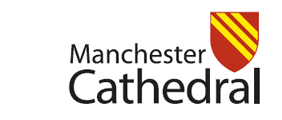Manchester Cathedral Timeline
A timeline of the Cathedral's history, from the 7th century up until recent times.
- 7th
century The first church in Manchester was built, possibly near to where St Anne’s Church now stands.
- 923
Following the destruction of the first church by the Danes, King Edward the Elder builds a new place of worship possibly on the same site as the present church. This is the St Mary’s church mentioned in the Domesday Book.
- 1215
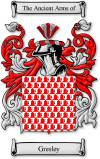 The present church is built within the precincts of the Baron’s Court, beside the Manor House (which is now part of Chetham’s Music School). The Lords of the Manor were the Greslet family, sometimes spelled Grelley or Gresley and the family coat of arms is still in use in the church today.
The present church is built within the precincts of the Baron’s Court, beside the Manor House (which is now part of Chetham’s Music School). The Lords of the Manor were the Greslet family, sometimes spelled Grelley or Gresley and the family coat of arms is still in use in the church today.
- Before
1311 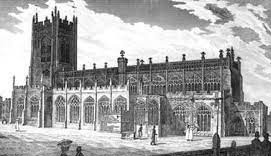
The Gresley family build and endow the first Chantry, the St Nicholas Chantry. Built around 1215 by the Greslet family, before it was passed on to the de la Ware family in 1311. It was endowed in 1349 and rebuilt by the de Trafford family in 1470. The chapel occupied two bays. It was one of five such chapels which existed within the church; all of which were abolished as chantries during the Reformation. The defining screens have been removed making it look like double aisles on each side of the nave.
- 1311
 The succession of the Gresley family ends and the estate is passed, by marriage, to the de la Warre family.
The succession of the Gresley family ends and the estate is passed, by marriage, to the de la Warre family.
- 1330
-
1360 The delicately carved entrance arch into the Lady Chapel (1350), and the former tower are built.
- 1349
The St Nicholas Chantry is endowed by the de Trafford family.
- 1359
Thomas de la Warre becomes Rector of the parish church.
- 1398
 Following the death of his brother, Thomas de la Warre becomes Baron of Manchester.
Following the death of his brother, Thomas de la Warre becomes Baron of Manchester.
- 1421
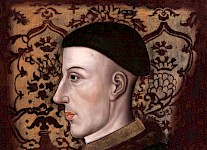 1421, 22 May: King Henry V issues a charter, licensing the conversion of the parish church of St Mary in Manchester into a Collegiate Church dedicated to St Mary, St George and St Denys.
1421, 22 May: King Henry V issues a charter, licensing the conversion of the parish church of St Mary in Manchester into a Collegiate Church dedicated to St Mary, St George and St Denys.
- 1422
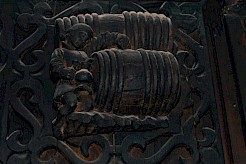 1422-58: John Huntingdon, first Warden (d.1458), whose rebus, showing a tun(barrel of ale) can be seen in the Quire ceiling, receives further grants of land from Reginald West for the building of domestic accommodation for the fellows of the Collegiate Church.
1422-58: John Huntingdon, first Warden (d.1458), whose rebus, showing a tun(barrel of ale) can be seen in the Quire ceiling, receives further grants of land from Reginald West for the building of domestic accommodation for the fellows of the Collegiate Church.
- 1426

Thomas de la Warre dies, leaving £3,000 to be used on the buildings of his collegiate foundation. Most of this goes on converting the Baron’s Hall into the house-of-residence for the College Priests or Fellows.
- 1440
-
1458 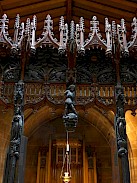 During his wardenship John Huntington undertakes the building of the Quire, or chancel, at his own expense. In 1440 the carved screen to the Lady Chapel is completed.
During his wardenship John Huntington undertakes the building of the Quire, or chancel, at his own expense. In 1440 the carved screen to the Lady Chapel is completed.
- 1465
-
1481 Warden Ralph Langley rebuilds the Nave, in a style harmonizing with the grace of his predecessors architecture.
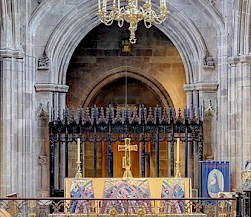 The Chancel Arch is added, with two flanking staircases dividing the Nave and the Quire.
The Chancel Arch is added, with two flanking staircases dividing the Nave and the Quire.
- 1481
-
2 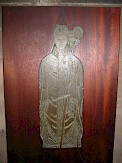 1481-1506, James Stanley II (1465-1515), stepson of Margaret Beaufort and subsequently Bishop of Ely, is fifth Warden of the Collegiate Church from 1485 to 1509.
1481-1506, James Stanley II (1465-1515), stepson of Margaret Beaufort and subsequently Bishop of Ely, is fifth Warden of the Collegiate Church from 1485 to 1509.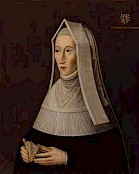 His eldest brother, Sir Thomas Stanley, marries Lady Margaret Beaufort, mother of Henry Tudor
His eldest brother, Sir Thomas Stanley, marries Lady Margaret Beaufort, mother of Henry Tudor
- 1485
Lord Thomas Stanley and his brother, Sir William Stanley, lead a contingent of men from Lancashire and Cheshire against King Richard III at the Battle of Bosworth Field, and were instrumental in securing such a decisive victory and the beginning of the Tudor dynasty.
 Sometime after this Lady Margaret Beaufort probably commissioned the famous consort of Minstrel Angels which were placed in the nave.
Sometime after this Lady Margaret Beaufort probably commissioned the famous consort of Minstrel Angels which were placed in the nave.
- 1501
1501: The St George Chantry is built by the Manchester merchant William Galley. It is located next to the St Nicholas Chantry.
 1500-06: Quire stalls and misericords completed by James Stanley II.
1500-06: Quire stalls and misericords completed by James Stanley II.
- 1506
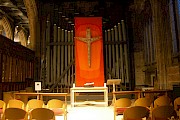 The Jesus Chapel is built and established “to the praise of God, and to the honour of the Saviour and of the name Jesus” by the Bexwicke family.
The Jesus Chapel is built and established “to the praise of God, and to the honour of the Saviour and of the name Jesus” by the Bexwicke family.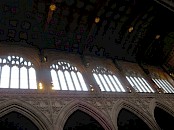 The Chapter House is rebuilt over the former Sacristy. The north columnade of the Nave is moved two feet north and the clerestory is added to let in more light.
The Chapter House is rebuilt over the former Sacristy. The north columnade of the Nave is moved two feet north and the clerestory is added to let in more light.
- 1513
 1513: work commences on the St John the Baptist chapel (now the Regimental Chapel), endowed by James Stanley, Bishop of Ely. The building was a joint venture with his son John in thanksgiving for the latter’s safe return from and knighted after his part in the Battle from Flodden Field.
1513: work commences on the St John the Baptist chapel (now the Regimental Chapel), endowed by James Stanley, Bishop of Ely. The building was a joint venture with his son John in thanksgiving for the latter’s safe return from and knighted after his part in the Battle from Flodden Field.
- 1515
James Stanley dies. A small chapel, the Ely Chapel is built adjacent to the St John the Baptist Chapel to hold his grey, marble tomb.
- 1545
Henry VIII undertakes an inventory of all the goods in the ancient churches.
- 1547
 1547, 9 July: Manchester College is dissolved by King Edward VI under the Second Abolition of Chantries Act and the land sold to Edward Stanley, Third Earl of Derby.
1547, 9 July: Manchester College is dissolved by King Edward VI under the Second Abolition of Chantries Act and the land sold to Edward Stanley, Third Earl of Derby.
- 1550
 Edward VI undertakes another inventory. This time all of the Church plate is confiscated.
Edward VI undertakes another inventory. This time all of the Church plate is confiscated.
- 1553
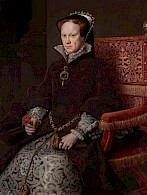 The College is re-founded by Mary 1, under the same terms as the first Charter, although the domestic accommodation remains in Derby hands.
The College is re-founded by Mary 1, under the same terms as the first Charter, although the domestic accommodation remains in Derby hands.
- 1573
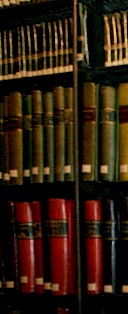 Collegiate Church parish registers begin and have continued ever since
Collegiate Church parish registers begin and have continued ever since
- 1578
 1578: Queen Elizabeth I dissolve the Marian college and re-founds it as the College of Christ in Manchester.
1578: Queen Elizabeth I dissolve the Marian college and re-founds it as the College of Christ in Manchester. 1595-1608: Dr John Dee (1527-1609), mathematician, astronomer, astrologer and adviser to Elizabeth I, is ninth Warden and lives in the college domestic accommodation.
1595-1608: Dr John Dee (1527-1609), mathematician, astronomer, astrologer and adviser to Elizabeth I, is ninth Warden and lives in the college domestic accommodation.
- 1617
1617
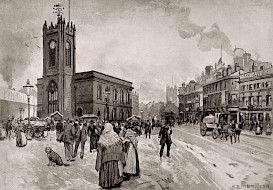 : Humphrey Booth of Salford pays for Holy Trinity Church and for the erection of a gallery in the Collegiate Church south aisle.
: Humphrey Booth of Salford pays for Holy Trinity Church and for the erection of a gallery in the Collegiate Church south aisle.
- 1635
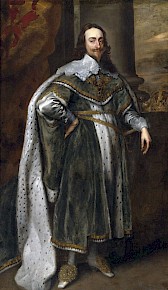 1635: After neglect by Warden Richard Murray, the Collegiate Church is re-founded a third time by a charter of King Charles I, after a petition led by Humphrey Chetham
1635: After neglect by Warden Richard Murray, the Collegiate Church is re-founded a third time by a charter of King Charles I, after a petition led by Humphrey Chetham
- 1642
 18 July: The Burial in the Collegiate Church of Richard Percival, linenwebster of Kirkmanshulmeand the first fatality of the Civil War.
18 July: The Burial in the Collegiate Church of Richard Percival, linenwebster of Kirkmanshulmeand the first fatality of the Civil War. 24 September - 2 October: Royalists siege of Manchester at Salford Bridge, led by James, Lord Strange, 7th Earl of Derby: damage to Collegiate Church.
24 September - 2 October: Royalists siege of Manchester at Salford Bridge, led by James, Lord Strange, 7th Earl of Derby: damage to Collegiate Church.
- 1649
The church is damaged during the Civil War.
- 1653
2
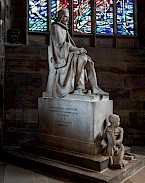 0 September: Death of Humphey Chetham, merchant, financier, Lord Lieutenant of Lancashire; benefactor; funeral procession at Collegiate Church on 12 October.
0 September: Death of Humphey Chetham, merchant, financier, Lord Lieutenant of Lancashire; benefactor; funeral procession at Collegiate Church on 12 October.
- 1660
Another gallery is erected across the west end of the Nave, with another one being built on the north side.
- 1698
The last gallery is erected to the north-west of the Nave.
- Pre
-
1700 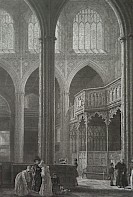 Chetham's gallery built at west end of church.
Chetham's gallery built at west end of church.
- 1742
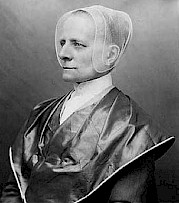 1742: Baptism in Collegiate Church of Ann Lee (1736-84) born in Toad Lane, and a founder of the Shaker sect; she emigrates to North America, with followers, in 1774
1742: Baptism in Collegiate Church of Ann Lee (1736-84) born in Toad Lane, and a founder of the Shaker sect; she emigrates to North America, with followers, in 1774
- 1745
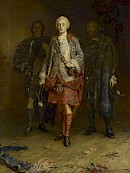 1745, 30 November: Prince Charles Edward Stuart (the Young Pretender) attends a service at the Collegiate Church and reviews the local Jacobite volunteers in the churchyard.
1745, 30 November: Prince Charles Edward Stuart (the Young Pretender) attends a service at the Collegiate Church and reviews the local Jacobite volunteers in the churchyard.
- 1781
 1781: Founding of the Manchester Literary and Philosophical Society; early meetings held at Cross Street.
1781: Founding of the Manchester Literary and Philosophical Society; early meetings held at Cross Street.
- 1787
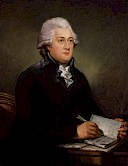 28 October: Thomas Clarkson (1760-1846), leading figure in the Committee for the Abolition of the Slave Trade, on his return from Liverpool to London tocollect information about slavery, preached at the Collegiate Church and a Manchester petition is launched.
28 October: Thomas Clarkson (1760-1846), leading figure in the Committee for the Abolition of the Slave Trade, on his return from Liverpool to London tocollect information about slavery, preached at the Collegiate Church and a Manchester petition is launched.
- 1790-1821
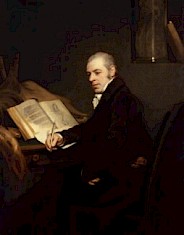 Revd Joshua Brookes, master at Manchester Grammer School and chaplain at Collegiate Church, is amongst those who conduct mass baptisms and Weddings.
Revd Joshua Brookes, master at Manchester Grammer School and chaplain at Collegiate Church, is amongst those who conduct mass baptisms and Weddings.
- 1814
North gallery re-erected.
- 1815
South gallery re-erected.
- 1814-18
All of the interior stonework is ‘picked’ and then coated with Roman cement.
- 1819
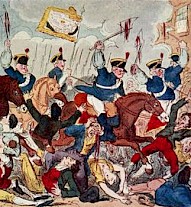 19 December: Burial of Mary Heyes at the Collegiate Church:injured while pregnant at the Peterloo Massacre in August and eventually dies in the December from her injuries.
19 December: Burial of Mary Heyes at the Collegiate Church:injured while pregnant at the Peterloo Massacre in August and eventually dies in the December from her injuries.
- 1847
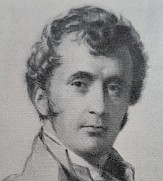 1847: James Prince Lee, DD, was the founding bishop of the new Manchester Diocese, when the Collegiate Church became Manchester Cathedral.
1847: James Prince Lee, DD, was the founding bishop of the new Manchester Diocese, when the Collegiate Church became Manchester Cathedral.
- 1855
The Cathedra, or Bishop’s throne is erected.
- 1862-68
The Roman cement is cleaned off and the galleries demolished.1862- 68: the tower had become dangerous and was replaced with a new one, designed by J.P. Holden.
- 1866
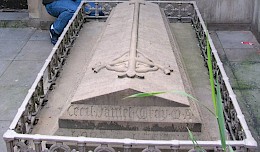 April 7: Death of Canon Cecil Wray, chaplain, fellow and co-worker with Joshua Beookes from 1809 (3157 marriages are recorded for 1834, and 7285 baptisms for 1837); institutes a charity, “Wray’s Birthday Gift”.
April 7: Death of Canon Cecil Wray, chaplain, fellow and co-worker with Joshua Beookes from 1809 (3157 marriages are recorded for 1834, and 7285 baptisms for 1837); institutes a charity, “Wray’s Birthday Gift”.
- 1868
 The new tower, an exact replica but six feet higher than the previous one, is formally opened. The outer face of the Cathedral is renewed.
The new tower, an exact replica but six feet higher than the previous one, is formally opened. The outer face of the Cathedral is renewed.
- 1882-3
The whole of the Nave interior is replaced, stone for stone under the direction of Joseph Crowther.
- 1888
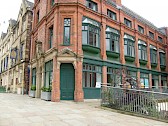 1888: Hanging Bridge Chambers built over newly re-discovered Hanging Bridge, which becomes a major visitor attraction.
1888: Hanging Bridge Chambers built over newly re-discovered Hanging Bridge, which becomes a major visitor attraction.
- 1891
A new south porch is built.
- 1892
The Baptistry extension is built.
- 1897
The Victoria Porch is built to celebrate the Diamond Jubilee of Queen Victoria.
1898: the building of the West End and Porch, designed by Basil Champneys after the completion of his Rylands Library, is completed during deanship of Edward McClure.
- 1898
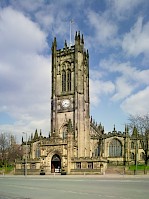 The building of the West End and Porch, designed by Basil Champneys after the completion of his Rylands Library is completed during deanship of Edward McClure.
The building of the West End and Porch, designed by Basil Champneys after the completion of his Rylands Library is completed during deanship of Edward McClure.
- 1904
1904:
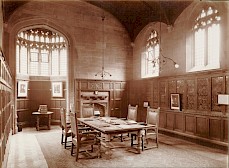 the south-east annex, including the Bishop Wickham Library, also designed by Basil Champneys, is completed.
the south-east annex, including the Bishop Wickham Library, also designed by Basil Champneys, is completed.
- 1934
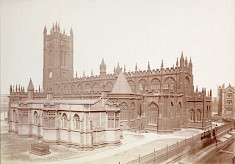 1933-1936: The building of a further south-east extension, designed by Percy Scott Worthington, takes place. Refectory and Choir School are built.
1933-1936: The building of a further south-east extension, designed by Percy Scott Worthington, takes place. Refectory and Choir School are built.
- 1936
The Derby C
 hapel, once the St John the Baptist Chantry, is given over to the Manchester Regiment on 11th November.
hapel, once the St John the Baptist Chantry, is given over to the Manchester Regiment on 11th November.
- 1940
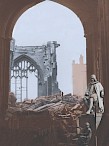 22 December: north-east corner of Cathedral destroyed by German Luftwaffe landmine; much internal damage.
22 December: north-east corner of Cathedral destroyed by German Luftwaffe landmine; much internal damage.
- 1941
-
1960 Restoration takes almost 20 years.
- 1964
-
83 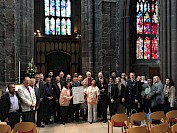 Alfred Jowett (1914-2004) CBE and a leading national campaigner for social equality becomes Dean of the Cathedral.
Alfred Jowett (1914-2004) CBE and a leading national campaigner for social equality becomes Dean of the Cathedral.
- 1972
-
1995 




The West Windows are replaced in stained glass by the artist Antony Hollaway. The first window to be commissioned was the St.George window in 1972 (second image from the left). This was followed by the St. Denys window in 1976 ( 2nd image from the right), the St. Mary window in 1980 (centre), the Creation window in 1991 (far left) and the Revelation window in 1995 (far right). Not since William of Sens put his team to the glazing of Canterbury Cathedral in 1174 had the complete West end of an English Cathedral been reglazed by the same designer in the space of twenty-three years. (The images are in situ as when facing west.)
- 1996
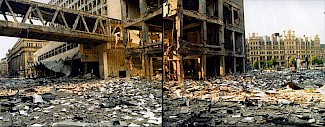 15 June: IRA bomb in Deansgate; significant damage to the Cathedral, including to the Fire Window.
15 June: IRA bomb in Deansgate; significant damage to the Cathedral, including to the Fire Window.
- 2016




 6 December 2016: The Installation of the Hope Window (2nd image from left), designed by Alan Davis, comissioned by The Oglesby Charitable Trust completes the stained Glass windows found at the East End of the Cathedral. The window is dedicated to the character and vibrancy of Manchester. The window sits along side the Fire window, (Regiment Chapel,1966, far left), the East window above the Lady chapel in memory of Henry Boddinton (1945, centre), the Healing window, designed by Linda Walton (2004 2nd from right) and the Fraser chapel window designed by Mark Cazalet.(2001, far right). (The images are in situ as when facing east.)
6 December 2016: The Installation of the Hope Window (2nd image from left), designed by Alan Davis, comissioned by The Oglesby Charitable Trust completes the stained Glass windows found at the East End of the Cathedral. The window is dedicated to the character and vibrancy of Manchester. The window sits along side the Fire window, (Regiment Chapel,1966, far left), the East window above the Lady chapel in memory of Henry Boddinton (1945, centre), the Healing window, designed by Linda Walton (2004 2nd from right) and the Fraser chapel window designed by Mark Cazalet.(2001, far right). (The images are in situ as when facing east.)
- 2017
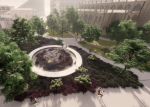 22 May: Manchester Arena terrorist attack in which 22 concert goers are killed; the Cathedral plays a role in spiritual recovery, including through the 2021 Glade of Light memorial.
22 May: Manchester Arena terrorist attack in which 22 concert goers are killed; the Cathedral plays a role in spiritual recovery, including through the 2021 Glade of Light memorial.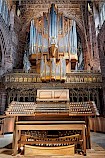 14 September: Dedication of the new Stoller Organ at the Cathedral, built by Tickell Organ Builders, and inaugural recital by Thomas Trotter.
14 September: Dedication of the new Stoller Organ at the Cathedral, built by Tickell Organ Builders, and inaugural recital by Thomas Trotter.
- 2021
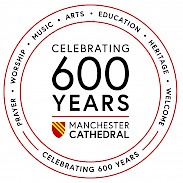 May 2021:- The Cathedral celebrates its 600th Anniversary of becoming a Collegiate Church.
May 2021:- The Cathedral celebrates its 600th Anniversary of becoming a Collegiate Church.
- 2021
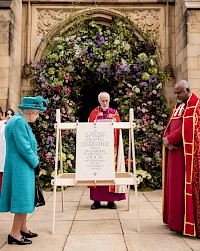 8 July: Her Magesty Queen Elizabeth II visited the Cathedral to celebrate the 600th Anniversary of the Collegiate Church.
8 July: Her Magesty Queen Elizabeth II visited the Cathedral to celebrate the 600th Anniversary of the Collegiate Church.
- 2022
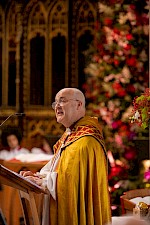 5 May: - A Special Service, after being delayed by a year due to the Covid pandemic, was finally held celebrating the 600th Anniversary of the Collegiate Church in the presence of The Most Reverend and Right Honourable Stephen Geoffrey Cottrell, The Lord Archbishop of York.
5 May: - A Special Service, after being delayed by a year due to the Covid pandemic, was finally held celebrating the 600th Anniversary of the Collegiate Church in the presence of The Most Reverend and Right Honourable Stephen Geoffrey Cottrell, The Lord Archbishop of York.
